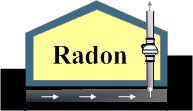 |
 |
Bill Brodhead WPB Enterprises Inc
Radon & Vapor Intrusion |
 |
 |
|
Bill Brodhead WPB Enterprises Inc.
Radon & Vapor Intrusion |
 |
 |
|
 |
Radon in Outdoor Air |
 |
 |
|
The EPA has made measurements of the radon levels outdoors across the United States. They have concluded that the average outdoor radon levels are around 0.4 pCi/L. Around 1990 I made a series of outdoor radon measurements at my own residence and at a home in Allentown Pennsylvania. The graphs below are the results of those measurements. These graphs clearly demonstrate how radon concentrations outdoors can rise significantly when there is very little wind or thermals that are induced by sunshine.
This first graph (above) was one of my earliest measurements. The measurements were taken three feet above grade in my back yard. Note that the first night there was a breeze and the radon levels only climbed to 0.5 pCi/L. On the following night when there was no breeze and the radon levels climbed to 3.2 pCi/L. During the day the radon levels dropped down to about zero. The overall average was 0.8 pCi/L which is well above the EPA average.
The graph above is outdoor radon measurements made at different heights over a three day period. The measurements were made at 6" above grade, 3 feet (1 meter) above grade and 18 feet (6 meters) above grade. The interesting fact is there is no difference in the outdoor radon measurements between 6" and 18 feet above grade. However on the second day the 18 foot measurement falls rapidly before the lower measurements as if a breeze cleared the air.
The graph above was outdoor measurements over 21 days at a home in Allentown, Pennsylvania. This location had lower outdoor radon levels (avg 0.36 pCi/L) than at my home in Springtown (Avg 0.8 pCi/L). Note the spikes that took place during some of the nights.
This final graph gives the average of each hour during those 21 days. This clearly shows that the highest outdoor radon levels are between 5 AM and 7 AM in the early morning before sunrise and the lowest outdoor radon is between 2 PM and 5 PM
|
 |
 |
Radon in Outdoor Air |
 |
 |
|
The EPA has made measurements of the radon levels outdoors across the United States. They have concluded that the average outdoor radon levels are around 0.4 pCi/L. Around 1990 I made a series of outdoor radon measurements at my own residence and at a home in Allentown Pennsylvania. The graphs below are the results of those measurements. These graphs clearly demonstrate how radon concentrations outdoors can rise significantly when there is very little wind or thermals that are induced by sunshine.
This first graph (above) was one of my earliest measurements. The measurements were taken three feet above grade in my back yard. Note that the first night there was a breeze and the radon levels only climbed to 0.5 pCi/L. On the following night when there was no breeze and the radon levels climbed to 3.2 pCi/L. During the day the radon levels dropped down to about zero. The overall average was 0.8 pCi/L which is well above the EPA average.
The graph above is outdoor radon measurements made at different heights over a three day period. The measurements were made at 6" above grade, 3 feet (1 meter) above grade and 18 feet (6 meters) above grade. The interesting fact is there is no difference in the outdoor radon measurements between 6" and 18 feet above grade. However on the second day the 18 foot measurement falls rapidly before the lower measurements as if a breeze cleared the air.
The graph above was outdoor measurements over 21 days at a home in Allentown, Pennsylvania. This location had lower outdoor radon levels (avg 0.36 pCi/L) than at my home in Springtown (Avg 0.8 pCi/L). Note the spikes that took place during some of the nights.
This final graph gives the average of each hour during those 21 days. This clearly shows that the highest outdoor radon levels are between 5 AM and 7 AM in the early morning before sunrise and the lowest outdoor radon is between 2 PM and 5 PM
|
 |
 |



